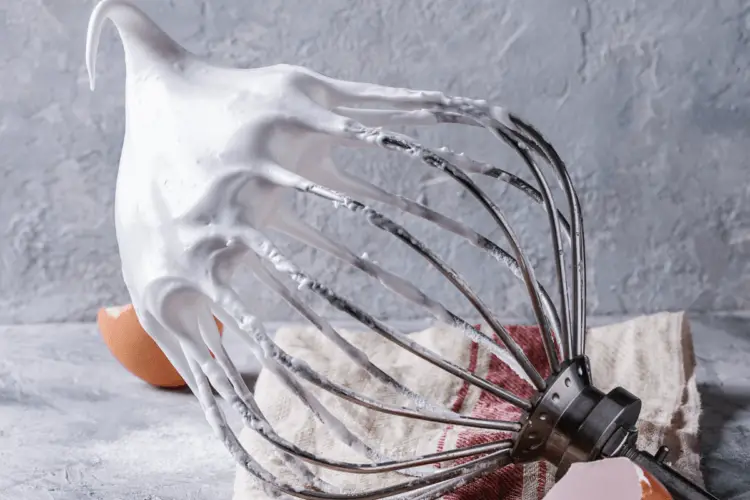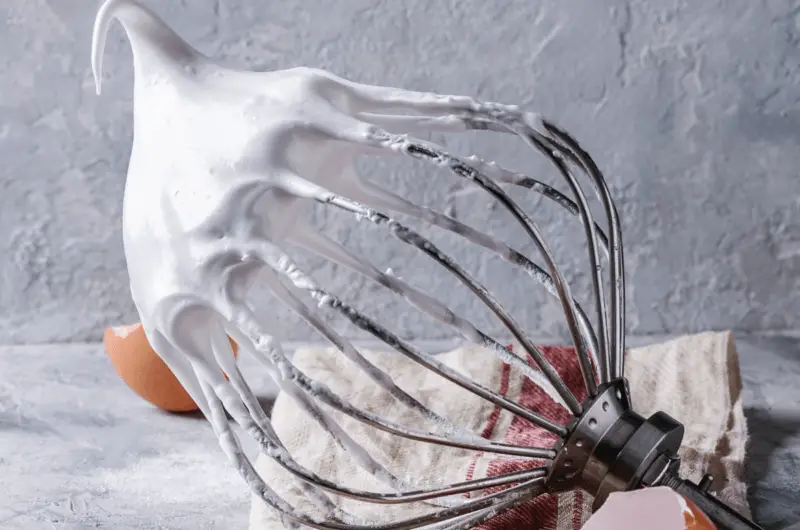Whichever Meringue you are thinking of producing, you are going to start with a simple combination of whisked egg whites and sugar.
It is the bringing together of the sugar and egg whites that will give you the finished article.
Here we lay out the three types (Swiss, French & Italian), how to make them.
French Meringue Recipe
Course: DessertCuisine: FrenchDifficulty: Easy15
minutes1
hour30
minutes828
kcal1
hour45
minutes
This is the basic meringue that is more commonly known to home cooking.
Ingredients
100 g egg whites you could use eggs that are a few days old as will give a better volume
100 g castor sugar
100 g icing sugar sifted
Directions
- Preheat the oven to 100C/200F/Gas mark 1/4
- Take a dry mixing bowl that is very clean and free from grease, Just to make sure wipe the inside of the bowl with a cut side wedge of lemon. ( any form of fat will prevent the egg whites from rising firmly).
- Separate the eggs individually into a cup before placing the whites into the mixing bowl. (See notes)
- Add a pinch of salt to the whites, and the castor sugar.
- Start whipping until they have fully risen.
- Sieve and gently fold the icing sugar into the mixture.
- Using a piping bag and desired shaped nozzle, pipe out the shape onto a baking tray lined with baking parchment (Do not use greaseproof paper)
- Place in the oven for at least 1 hour, you are trying to achieve a dried out meringue with no colour. (This timing is dependant on the size of meringue)
- If you can lift the meringue from the paper and they sound hollow when tapped on the bottom, then they are ready.
- When the meringues are ready, leave them in the oven until cold.
- Store in an airtight container until ready to use.
Italian Meringue Recipe
Italian meringue has a large range of uses. It is the most stable of the meringues, and it is also safe to eat without additional baking, due to the egg whites cooking as the high-temperature sugar syrup is added. which is why it is also used to make Italian buttercream frosting.
Details
20 mins
5 mins
1014
Directions
- Place the sugar and water in a medium sized saucepan and stir well to combine
- Bring the sugar mixture to the boil, if you see any sugar crystalising around the sides, brush the sides down with a brush and cold water. Place a sugar thermometer in the pan.
- Keep stirring to make sure the sugar is fully dissolved and keep an eye on the thermometer, you want the liquid to reach a temperature of 240 F (115C).
- When the sugar reaches that point turn the heat off, but leave the thermometer in the pan.
- Grab your stand mixer bowl and make sure the inside is very clean.It is a good idea to wipe the inside of the bowl with the lemon wedge at this point, this will make sure there is no grease in the bowl.
- Add the egg whites and lemon juice and whisk until soft peaks form.Check the sugar syrup is still at 240°F (115°C) if necessary reheat to bring back to the correct temperature, and set the speed of your stand mixer to low.
- Very slowly trickle the sugar syrup into the egg whites, keeping the mixer whisking at all times.( Keep the syrup away from the mixer whisk to save any splashing).
- Now all the syrup is mixed well with the egg whites turn the speed up to medium/high and keep whisking until the meringue is shiny, fluffy and forms firm peaks,(You are not looking for the peaks to be stiff) this could take around 3/4 minutes and the meringue will still be warm when you reach your peaks.
- The meringue is now ready to use as you wish.
If you are drying the meringue out to use as nests or shells, pipe out onto a baking tray lined with Baking Parchment and place in a preheated oven @100C and let them dry out for at least an hour. To test if they are ready, they should be able to be lifted from the parchment paper and sound hollow when tapped on the bottom
Swiss Meringue Recipe
Swiss meringue has a variety of uses and in particular in buttercream due to the egg whites being “cooked” with the sugar to a temperature of 160C.
Details
20 mins
5 mins
1014
Directions
- Choose a pan where the base of your stand mixer bowl will fit comfortably. Fill it halfway with water, check with your mixing bowl that the base of the bowl doesn’t touch the water.Turn on a medium heat and bring the water to a simmer.
- While waiting for the water to heat up, combine the egg whites and sugar in the stand mixer bowl. Whisk to mix.
- Set the bowl over the pot with simmering water. Using a wooden spoon or spatula, stir constantly until the sugar is completely dissolved into the egg whites.
- Still stirring, bring the egg whites and sugar mix up to a temperature of 160ºF, you can use a kitchen thermometer, or just run some liquid between your fingertips and thumb to check it is nice and smooth and not grainy to test.
- Place the bowl on your stand mixer with the whisk attachment. Add the lemon juice and starting on low, and gradually increasing the speed to high, beat the whites until they form a glossy meringue with stiff peaks. The meringue should cling to a spoon when turned upside down. This could take 5 or 6 minutes, so be patient.
- The meringue is now ready to use as you wish.If you are making nests for cream dessert, you will have to dry the meringues out in the oven set at 100C for about 3/4 hours, depending on the size of the nest.
- Again depending on your choice of usage, medium shell-like meringues will take 75 to 90 minutes. Pavlova-sized meringues will take 3/4 hours.
- If the meringue is dry and can be lifted from the baking parchment, tap the bottom and it should have a hollow sound, then they are ready.Once dried out, turn the oven off, leave the door ajar, and let meringues rest inside until completely cooled.


